





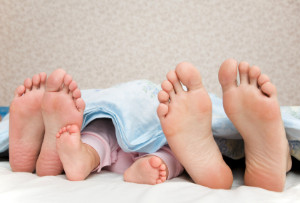 Children's foot and heel pain, or CFHP, encompasses a variety of conditions that can impact children’s ability to engage in activities and sports without discomfort. One common cause of CFHP is Sever's disease, a condition that results from inflammation of the growth plate in the heel. Sever’s disease is often seen in active children undergoing growth spurts. Additionally, flat feet or overpronation can strain the foot's muscles and ligaments, causing pain. Improper footwear, intense physical activity, and obesity may also contribute to the development of CFHP. Symptoms typically include pain in the foot or heel, particularly during or after physical activities, and might be accompanied by swelling or redness. Addressing CFHP involves a combination of rest, wearing appropriate footwear, and sometimes orthotic devices to support the foot's structure. Early diagnosis and treatment are important to prevent chronic problems and ensure that children can participate in their favorite activities without pain. If your child is suffering with foot or heel pain, it is suggested that you schedule an appointment with a podiatrist today.
Children's foot and heel pain, or CFHP, encompasses a variety of conditions that can impact children’s ability to engage in activities and sports without discomfort. One common cause of CFHP is Sever's disease, a condition that results from inflammation of the growth plate in the heel. Sever’s disease is often seen in active children undergoing growth spurts. Additionally, flat feet or overpronation can strain the foot's muscles and ligaments, causing pain. Improper footwear, intense physical activity, and obesity may also contribute to the development of CFHP. Symptoms typically include pain in the foot or heel, particularly during or after physical activities, and might be accompanied by swelling or redness. Addressing CFHP involves a combination of rest, wearing appropriate footwear, and sometimes orthotic devices to support the foot's structure. Early diagnosis and treatment are important to prevent chronic problems and ensure that children can participate in their favorite activities without pain. If your child is suffering with foot or heel pain, it is suggested that you schedule an appointment with a podiatrist today.
The health of a child’s feet is vital to their overall well-being. If you have any questions regarding foot health, contact one of our podiatrists of Active Foot and Ankle Care, LLC. Our doctors can provide the care you need to keep you pain-free and on your feet.
Tips for Keeping Children's Feet Healthy
If you have any questions, please feel free to contact our offices located in Fair Lawn, Riverdale, and Englewood, NJ . We offer the newest diagnostic and treatment technologies for all your foot care needs.
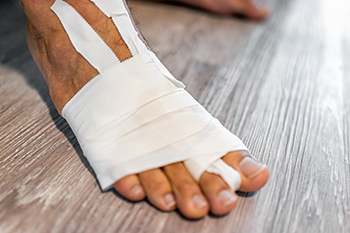 Turf toe is an injury common among athletes, particularly those who play on hard surfaces like artificial turf. It occurs when the big toe bends too far upwards, stretching or tearing the soft tissue underneath the toe joint. This type of injury is most often seen in sports that involve rapid starts, stops, and turns, leading to a sudden forceful impact on the toe. Symptoms of turf toe include pain at the base or joint of the big toe, swelling, and limited joint movement, making it difficult to walk or run. Some people also experience a popping sensation at the time of the injury. Symptoms may be more severe if there is extensive damage to the soft tissue. Proper diagnosis and treatment are important to manage pain, reduce inflammation, and ensure a full recovery. If you have big toe joint pain, it is suggested that you make an appointment with a podiatrist, or foot doctor, for diagnosis. Turf toe is not the only possible cause of big toe joint pain, and each condition has specialized treatment that podiatrists may recommend.
Turf toe is an injury common among athletes, particularly those who play on hard surfaces like artificial turf. It occurs when the big toe bends too far upwards, stretching or tearing the soft tissue underneath the toe joint. This type of injury is most often seen in sports that involve rapid starts, stops, and turns, leading to a sudden forceful impact on the toe. Symptoms of turf toe include pain at the base or joint of the big toe, swelling, and limited joint movement, making it difficult to walk or run. Some people also experience a popping sensation at the time of the injury. Symptoms may be more severe if there is extensive damage to the soft tissue. Proper diagnosis and treatment are important to manage pain, reduce inflammation, and ensure a full recovery. If you have big toe joint pain, it is suggested that you make an appointment with a podiatrist, or foot doctor, for diagnosis. Turf toe is not the only possible cause of big toe joint pain, and each condition has specialized treatment that podiatrists may recommend.
Toe pain can disrupt your daily activities. If you have any concerns, contact one of our podiatrists of Active Foot and Ankle Care, LLC. Our doctors can provide the care you need to keep you pain-free and on your feet.
What Causes Toe Pain?
Most severe toe pain is caused due to a sports injury, trauma from dropping something heavy on the toe, or bumping into something rigid. Other problems can develop over time for various reasons.
Toe pain can be caused by one or more ailments. The most common include:
When to See a Podiatrist
Diagnosis
In many cases the cause of toe pain is obvious, but in others, a podiatrist may want to use more advanced methods to determine the problem. These can range from simple visual inspections and sensation tests to X-rays and MRI scans. Prior medical history, family medical history, and any recent physical traumatic events will all be taken into consideration for a proper diagnosis.
Treatment
Treatments for toe pain and injuries vary and may include shoe inserts, padding, taping, medicines, injections, and in some cases, surgery. If you believe that you have broken a toe, please see a podiatrist as soon as possible.
If you have any questions please feel free to contact our offices located in Fair Lawn, Riverdale, and Englewood, NJ . We offer the newest diagnostic tools and technology to treat your foot and ankle needs.
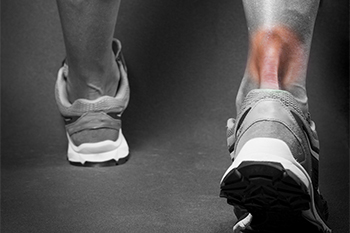
Achilles tendonitis, an inflammation of the Achilles tendon, disrupts the smooth functioning of the tendon connecting the calf muscles to the heel bone. Contributing factors include tight calf muscles and excessive running up and down hills. Sudden increases in exercise intensity or duration of activity and wearing improper footwear, such as stiff-soled shoes or high heels, are other causes of Achilles tendonitis. Athletes engaging in activities that involve repetitive jumping or sudden stops or starts are particularly prone to overuse injuries like Achilles tendonitis. The main symptom is pain along the tendon, especially near the heel. Other signs of Achilles tendonitis can include swelling, warmth, and tenderness over the affected area. Difficulty rising on the toes or pushing off while walking, in addition to morning heel pain accompanied by ankle stiffness are further indicators. Recovery for Achilles tendonitis typically includes anti-inflammatory medication, rehabilitation exercises, and use of walking boots or casts for immobilization. If you are experiencing symptoms of Achilles tendonitis, it is suggested that you schedule an appointment with a podiatrist for an exam, diagnosis, and personalized treatment.
Achilles tendon injuries need immediate attention to avoid future complications. If you have any concerns, contact one of our podiatrists of Active Foot and Ankle Care, LLC. Our doctors can provide the care you need to keep you pain-free and on your feet.
What Is the Achilles Tendon?
The Achilles tendon is a tendon that connects the lower leg muscles and calf to the heel of the foot. It is the strongest tendon in the human body and is essential for making movement possible. Because this tendon is such an integral part of the body, any injuries to it can create immense difficulties and should immediately be presented to a doctor.
What Are the Symptoms of an Achilles Tendon Injury?
There are various types of injuries that can affect the Achilles tendon. The two most common injuries are Achilles tendinitis and ruptures of the tendon.
Achilles Tendinitis Symptoms
Rupture Symptoms
Treatment and Prevention
Achilles tendon injuries are diagnosed by a thorough physical evaluation, which can include an MRI. Treatment involves rest, physical therapy, and in some cases, surgery. However, various preventative measures can be taken to avoid these injuries, such as:
If you have any questions please feel free to contact our offices located in Fair Lawn, Riverdale, and Englewood, NJ . We offer the newest diagnostic tools and technology to treat your foot and ankle needs.
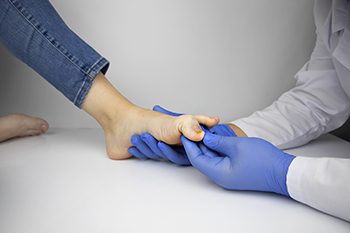
Dealing with stubborn fungal toenails? Surgical toenail removal might be the solution. This procedure is typically done in a podiatrist's office under local anesthesia to ensure comfort. The toenail removal process involves loosening the skin around the toenail and removing either the entire nail or just the affected portion, depending on the severity of the infection. To prevent regrowth and future fungal toenail infections, the nail matrix can be destroyed using a chemical solution after removal. Post-surgery, proper wound care includes gentle washing with clean water and avoiding harsh substances like hydrogen peroxide or alcohol. Healing usually takes a few weeks, with toenails growing back within a year to 18 months. Surgical toenail removal is reserved for cases where a significant portion of the nail is diseased or causing severe pain. If fungal toenails are impacting your life, it is suggested that you make an appointment with a podiatrist to explore treatment options, including surgical intervention if necessary.
If left untreated, toenail fungus may spread to other toenails, skin, or even fingernails. If you suspect you have toenail fungus it is important to seek treatment right away. For more information about treatment, contact one of our podiatrists of Active Foot and Ankle Care, LLC. Our doctors can provide the care you need to keep you pain-free and on your feet.
Symptoms
Treatment
If self-care strategies and over-the-counter medications does not help your fungus, your podiatrist may give you a prescription drug instead. Even if you find relief from your toenail fungus symptoms, you may experience a repeat infection in the future.
Prevention
In order to prevent getting toenail fungus in the future, you should always make sure to wash your feet with soap and water. After washing, it is important to dry your feet thoroughly especially in between the toes. When trimming your toenails, be sure to trim straight across instead of in a rounded shape. It is crucial not to cover up discolored nails with nail polish because that will prevent your nail from being able to “breathe”.
In some cases, surgical procedure may be needed to remove the toenail fungus. Consult with your podiatrist about the best treatment options for your case of toenail fungus.
If you have any questions, please feel free to contact our offices located in Fair Lawn, Riverdale, and Englewood, NJ . We offer the newest diagnostic and treatment technologies for all your foot care needs.
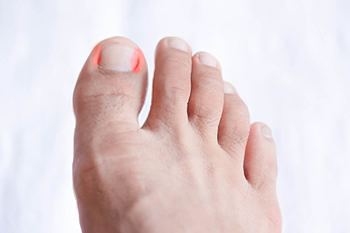
An ingrown toenail happens when the nail's edges grow into the adjacent skin, causing pain and possible infection. Typically affecting the big toe, an ingrown toenail presents with swelling, redness, and potential infection. Home treatment is possible, but severe pain or spreading requires professional attention to avoid complications. Consultation with a podiatrist is vital, especially for those individuals with conditions such as diabetes or poor circulation. Over-the-counter remedies only mask pain, they do not solve the issue. Surgery may be necessary if symptoms persist, with options including partial or total nail avulsion under local anesthesia. After surgery, proper care is essential to prevent infection, and antibiotics may be prescribed if infection occurs. If you have an ingrown toenail, it is suggested that you schedule an appointment with a podiatrist to get treatment underway immediately.
Ingrown toenails may initially present themselves as a minor discomfort, but they may progress into an infection in the skin without proper treatment. For more information about ingrown toenails, contact one of our podiatrists of Active Foot and Ankle Care, LLC. Our doctors can provide the care you need to keep you pain-free and on your feet.
Ingrown Toenails
Ingrown toenails are caused when the corner or side of a toenail grows into the soft flesh surrounding it. They often result in redness, swelling, pain, and in some cases, infection. This condition typically affects the big toe and may recur if it is not treated properly.
Causes
You are more likely to develop an ingrown toenail if you are obese, have diabetes, arthritis, or have any fungal infection in your nails. Additionally, people who have foot or toe deformities are at a higher risk of developing an ingrown toenail.
Symptoms
Some symptoms of ingrown toenails are redness, swelling, and pain. In rare cases, there may be a yellowish drainage coming from the nail.
Treatment
Ignoring an ingrown toenail can have serious complications. Infections of the nail border can progress to a deeper soft-tissue infection, which can then turn into a bone infection. You should always speak with your podiatrist if you suspect you have an ingrown toenail, especially if you have diabetes or poor circulation.
If you have any questions, please feel free to contact our offices located in Fair Lawn, Riverdale, and Englewood, NJ . We offer the newest diagnostic and treatment technologies for all your foot care needs.
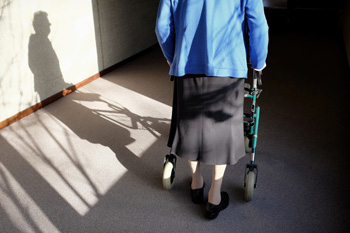
As we age, foot problems can pose significant challenges, making it harder to maintain physical activity and increasing the risk of falls. Conditions such as bunions, corns, calluses, and warts can cause discomfort and hinder mobility, impacting overall quality of life. To ensure healthy and pain-free feet, maintaining proper foot hygiene by keeping the feet clean and dry and regularly trimming toenails to prevent ingrown nails is even more important. However, seeking professional care is equally important. Regular visits to a podiatrist can help detect and address foot issues early, preventing them from worsening and reducing the risk of complications. Podiatrists can provide personalized advice on foot care, recommend appropriate footwear, and offer treatments tailored to individual needs, promoting optimal foot health and mobility in older adults. If you are elderly or taking care of someone in this age group, it is strongly suggested that you incorporate regular visits to a podiatrist into your healthcare routine.
Proper foot care is something many older adults forget to consider. If you have any concerns about your feet and ankles, contact one of our podiatrists from Active Foot and Ankle Care, LLC. Our doctors can provide the care you need to keep you pain-free and on your feet.
The Elderly and Their Feet
As we age we start to notice many changes in our body, but the elder population may not notice them right away. Medical conditions may prevent the elderly to take notice of their foot health right away. Poor vision is a lead contributor to not taking action for the elderly.
Common Conditions
Susceptible Infections
Diabetes and poor circulation can cause general loss of sensitivity over the years, turning a simple cut into a serious issue.
If you have any questions please feel free to contact our offices located in Fair Lawn, Riverdale, and Englewood, NJ . We offer the newest diagnostic and treatment technologies for all your foot and ankle needs.
 In colder weather, blisters can form on the feet due to a combination of factors related to temperature and moisture. Wearing heavy socks and shoes in the winter can lead the feet to sweat that accumulates inside your socks and shoes. This moisture, combined with reduced evaporation rates in colder temperatures, creates a damp environment around the feet. As a result, the skin becomes softer and more prone to damage from friction and rubbing against socks or shoes. Chilblains, lesions on the hands and feet that appear after exposure to the cold, can also blister. They appear within 24 hours of cold exposure and are caused by tiny blood vessels expanding too quickly once the body is exposed to heat again. If you have foot blisters after cold exposure, it is suggested you consult a podiatrist to conduct an exam and offer options to help with recurrent blister formation from chilblains.
In colder weather, blisters can form on the feet due to a combination of factors related to temperature and moisture. Wearing heavy socks and shoes in the winter can lead the feet to sweat that accumulates inside your socks and shoes. This moisture, combined with reduced evaporation rates in colder temperatures, creates a damp environment around the feet. As a result, the skin becomes softer and more prone to damage from friction and rubbing against socks or shoes. Chilblains, lesions on the hands and feet that appear after exposure to the cold, can also blister. They appear within 24 hours of cold exposure and are caused by tiny blood vessels expanding too quickly once the body is exposed to heat again. If you have foot blisters after cold exposure, it is suggested you consult a podiatrist to conduct an exam and offer options to help with recurrent blister formation from chilblains.
Blisters may appear as a single bubble or in a cluster. They can cause a lot of pain and may be filled with pus, blood, or watery serum. If your feet are hurting, contact one of our podiatrists of Active Foot and Ankle Care, LLC. Our doctors can provide the care you need to keep you pain-free and on your feet.
Foot Blisters
Foot blisters are often the result of friction. This happens due to the constant rubbing from shoes, which can lead to pain.
What Are Foot Blisters?
A foot blister is a small fluid-filled pocket that forms on the upper-most layer of the skin. Blisters are filled with clear fluid and can lead to blood drainage or pus if the area becomes infected.
Symptoms
(Blister symptoms may vary depending on what is causing them)
Prevention & Treatment
In order to prevent blisters, you should be sure to wear comfortable shoes with socks that cushion your feet and absorb sweat. Breaking a blister open may increase your chances of developing an infection. However, if your blister breaks, you should wash the area with soap and water immediately and then apply a bandage to the affected area. If your blisters cause severe pain it is important that you call your podiatrist right away.
If you have any questions, please feel free to contact our offices located in Fair Lawn, Riverdale, and Englewood, NJ . We offer the newest diagnostic and treatment technologies for all your foot care needs.
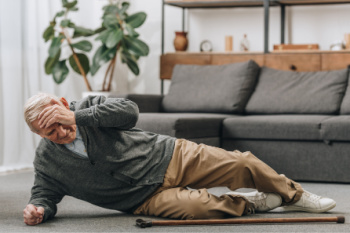
Balance is a fundamental aspect of daily life, affecting activities like walking, standing, and even tying your shoes. Recent research highlights its role in overall health, with studies revealing a correlation between poor balance and increased mortality risk. Incorporating balance exercises into your routine can lower this risk and improve stability. Here are a few exercises that aim to improve balance and reduce the likelihood of falling. It’s a good idea to have a chair or wall nearby to hold on to while performing them. The first is single-leg standing, where you elevate one leg while maintaining posture and gradually increase duration. Next is heel-to-toe walking, simulating a tightrope walk to enhance balance and coordination. Finally, integrating yoga practice can help to improve body awareness and proprioception, which is needed for equilibrium. Whether you're an athlete aiming for peak performance or an older adult with balance problems, these exercises can help reduce the risk of falls and promote overall well-being. For help with foot and ankle problems related to mobility or stability, it is suggested that you visit a podiatrist for a full exam.
Preventing falls among the elderly is very important. If you are older and have fallen or fear that you are prone to falling, consult with one of our podiatrists from Active Foot and Ankle Care, LLC. Our doctors will assess your condition and provide you with quality advice and care.
Every 11 seconds, an elderly American is being treated in an emergency room for a fall related injury. Falls are the leading cause of head and hip injuries for those 65 and older. Due to decreases in strength, balance, senses, and lack of awareness, elderly persons are very susceptible to falling. Thankfully, there are a number of things older persons can do to prevent falls.
How to Prevent Falls
Some effective methods that older persons can do to prevent falls include:
Falling can be a traumatic and embarrassing experience for elderly persons; this can make them less willing to leave the house, and less willing to talk to someone about their fears of falling. Doing such things, however, will increase the likelihood of tripping or losing one’s balance. Knowing the causes of falling and how to prevent them is the best way to mitigate the risk of serious injury.
If you have any questions, please feel free to contact our offices located in Fair Lawn, Riverdale, and Englewood, NJ . We offer the newest diagnostic and treatment technologies for all your foot care needs.
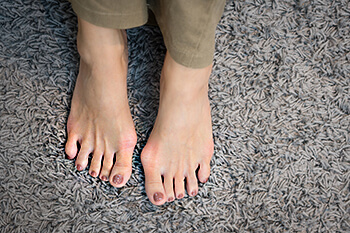
Have questions about bunion surgery and the Lapiplasty® Procedure?
How is the Lapiplasty® Procedure different?
Can I really get back on my feet quickly?
Will my bunion return?
Is it covered by insurance?
How can I find a doctor near me?
Watch our webinar on February 13th from your PC or Mac and get your questions answered by Dr. Braver, LIVE. Please also feel free to submit any questions ahead of time.
Click here to register.
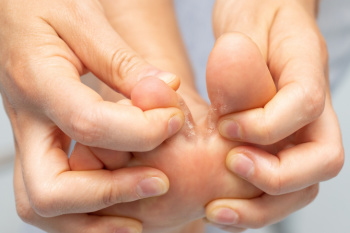 Athlete’s foot is a fungal infection that causes blisters and peeling skin on the feet. This contagious infection is generally treated with topical antifungal medications. If left untreated, athlete's foot can lead to more severe problems than the itching and redness associated with the infection. If ignored, the infection can spread to other parts of the foot, such as the toenails or the soles of the feet. As the condition progresses, it may result in painful blisters, cracks, and open sores, making daily activities like walking or standing uncomfortable. In some cases, untreated athlete's foot can contribute to the development of secondary bacterial infections, which can include swollen and painful feet. These secondary infections can also cause fever and lymph node infections. Some patients also experience allergic reactions to the initial fungal infection, causing blisters on the infected area. Podiatrists can prescribe antifungal medications and provide more information on foot hygiene to effectively quell a case of athlete’s foot. If you suspect you have athlete’s foot, it is suggested that you seek prompt treatment from a podiatrist to treat the infection and prevent it from worsening.
Athlete’s foot is a fungal infection that causes blisters and peeling skin on the feet. This contagious infection is generally treated with topical antifungal medications. If left untreated, athlete's foot can lead to more severe problems than the itching and redness associated with the infection. If ignored, the infection can spread to other parts of the foot, such as the toenails or the soles of the feet. As the condition progresses, it may result in painful blisters, cracks, and open sores, making daily activities like walking or standing uncomfortable. In some cases, untreated athlete's foot can contribute to the development of secondary bacterial infections, which can include swollen and painful feet. These secondary infections can also cause fever and lymph node infections. Some patients also experience allergic reactions to the initial fungal infection, causing blisters on the infected area. Podiatrists can prescribe antifungal medications and provide more information on foot hygiene to effectively quell a case of athlete’s foot. If you suspect you have athlete’s foot, it is suggested that you seek prompt treatment from a podiatrist to treat the infection and prevent it from worsening.
Athlete’s Foot
Athlete’s foot is often an uncomfortable condition to experience. Thankfully, podiatrists specialize in treating athlete’s foot and offer the best treatment options. If you have any questions about athlete’s foot, consult with one of our podiatrists from Active Foot and Ankle Care, LLC. Our doctors will assess your condition and provide you with quality treatment.
What Is Athlete’s Foot?
Tinea pedis, more commonly known as athlete’s foot, is a non-serious and common fungal infection of the foot. Athlete’s foot is contagious and can be contracted by touching someone who has it or infected surfaces. The most common places contaminated by it are public showers, locker rooms, and swimming pools. Once contracted, it grows on feet that are left inside moist, dark, and warm shoes and socks.
Prevention
The most effective ways to prevent athlete’s foot include:
Symptoms
Athlete’s foot initially occurs as a rash between the toes. However, if left undiagnosed, it can spread to the sides and bottom of the feet, toenails, and if touched by hand, the hands themselves. Symptoms include:
Diagnosis and Treatment
Diagnosis is quick and easy. Skin samples will be taken and either viewed under a microscope or sent to a lab for testing. Sometimes, a podiatrist can diagnose it based on simply looking at it. Once confirmed, treatment options include oral and topical antifungal medications.
If you have any questions, please feel free to contact our offices located in Fair Lawn, Riverdale, and Englewood, NJ . We offer the newest diagnostic and treatment technologies for all your foot care needs.
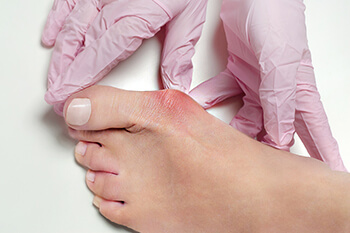
Have questions about bunion surgery and the Lapiplasty® Procedure?
How is the Lapiplasty® Procedure different?
Can I really get back on my feet quickly?
Will my bunion return?
Is it covered by insurance?
How can I find a doctor near me?
Watch our webinar on February 13th from your PC or Mac and get your questions answered by Dr. Braver, LIVE. Please also feel free to submit any questions ahead of time.
Click here to register.






